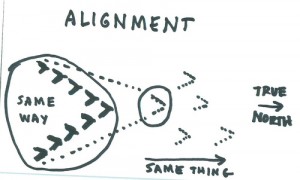How to Create a Successful Sales and Marketing Collaboration Plan
 It’s no secret: a well-oiled organization understands the necessity of inter-department collaboration and productive communication. In order to boost lead generation, keep leads nurtured and happy, and gain return customers, you must have a successful sales and marketing collaboration plan in place. Maintaining a healthy communication internally should translate to developing a strong engagement with the target audience which helps boost your rate of return.
It’s no secret: a well-oiled organization understands the necessity of inter-department collaboration and productive communication. In order to boost lead generation, keep leads nurtured and happy, and gain return customers, you must have a successful sales and marketing collaboration plan in place. Maintaining a healthy communication internally should translate to developing a strong engagement with the target audience which helps boost your rate of return.
Marketing automation, smartly implemented, can make this process easier and more efficient. However, without sales and marketing collaboration and alignment, your sales team will inevitably waste time following leads that just aren’t qualified (yet). By keeping both parties in the know on how to properly analyze your lead tracking practices, you’ll find it’s much easier to nurture leads and provide personalized marketing efforts. Cold calling everyone who signs up for your newsletter will probably deter leads from taking the next step and you’ll risk looking desperate. Strategize and implement a clear and concise protocol for points of contact to potential leads at the appropriate times.
Maintain two-way communication
Studies have shown that returning customers make up a significant portion of your revenue, so proper lead nurturing sets the stage for a lasting relationship. Ensure your sales and marketing collaboration plan includes guidelines on how and what is communicated between departments. This level of collaboration means greater customer satisfaction through better communicated ideas. Let your marketers set up sales for success through targeted marketing campaigns that communicate a positive message about your brand and delivers what the potential customers are looking for.
Keep tasks relevant and separate (don’t do the same thing twice)
While collaboration is key, it’s still a good idea to have tasks and responsibilities that the marketing team is responsible for, and tasks and responsibilities that the sales team is responsible for. This is the reason for the division—play up each department’s strengths. The marketing team should be able to create killer content that gives the sales team the upper hand when it’s their turn to reach out to qualified leads. Sales and marketing collaboration means communicating key points between departments, not consolidating the whole process into just one team or the other.
Strategic implementation of your marketing automation practices between sales and marketing is critical. Because most of your potential customers will find your brand through the internet, chances are they can easily find your competitors as well. Use the analytics from your marketing automation to draw up a plan of action for your leads as they request more information and take the next steps. The joint efforts of both departments will enforce this plan of action. The marketing team needs to head up key strategic, back-end development while the sales team can focus on maintaining lead (and customer) satisfaction. Keeping the customer in mind throughout the whole process means keeping everybody engaged and will provide the greatest return.











